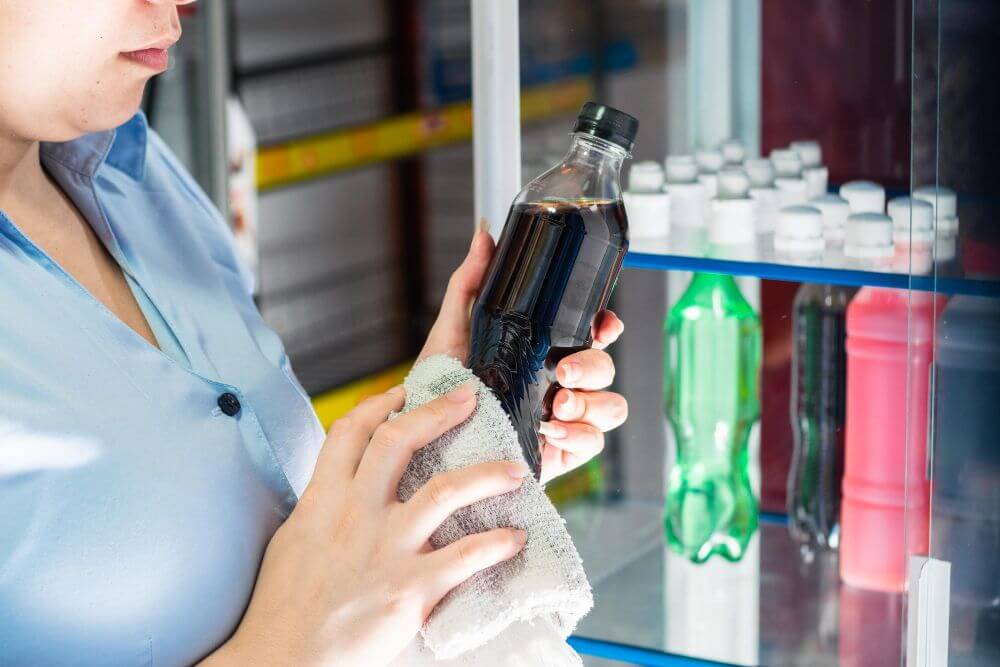How Many Times Can an Expendable Refrigerant Be Used? An expendable refrigerant can only be used once due to its chemical composition and function. It cannot be reused or recycled after its initial use.
In refrigeration systems or air conditioning units, expensive refrigerants are designed for single-use purposes. These refrigerants undergo chemical reactions during their operation and are ultimately consumed, which makes them unsuitable for reuse. Therefore, it is important to properly dispose of expendable refrigerants after their initial use to prevent any environmental harm.
Advantages Of Using Expendable Refrigerants
Expendable refrigerants offer numerous advantages because they can be used multiple times while maintaining effectiveness. With their cost-effectiveness and reduced environmental impact, these refrigerants provide a sustainable solution for cooling needs.
Expendable refrigerants offer several advantages over other types of refrigerants. These advantages include lower cost and easy availability, increased energy efficiency, and reduced environmental impact. Let’s take a closer look at each of these benefits:
Lower Cost And Easy Availability:
- Expendable refrigerants are cheaper compared to other types of refrigerants. This makes them an economical choice for both manufacturers and consumers.
- These refrigerants are readily available in the market, ensuring easy accessibility for businesses and individuals alike.
Increased Energy Efficiency:
- Expendable refrigerants have excellent heat transfer properties, allowing them to efficiently cool down the system components. This leads to reduced energy consumption and lower electricity bills.
- The use of expendable refrigerants in refrigeration systems can result in increased overall system efficiency. This is particularly important for commercial and industrial applications with significant energy costs.
Reduced Environmental Impact:
- Expendable refrigerants have a lower global warming potential (GWP) compared to some other types of refrigerants. This means they have a reduced impact on climate change when released into the atmosphere.
- Certain expendable refrigerants, such as natural refrigerants like carbon dioxide (CO2) and ammonia (NH3), have zero ozone depletion potential. This makes them environmentally friendly and compliant with international regulations.
- Additionally, the composition of expendable refrigerants can be optimized for more efficient recycling and disposal processes, further minimizing their environmental impact.
When it comes to refrigerants, using expendable options offers several benefits. They are cost-effective, readily available, and contribute to increased energy efficiency. Furthermore, they have a reduced environmental impact, making them a sustainable choice for refrigeration systems. By considering these advantages, businesses and individuals can make more informed decisions about the refrigerants they choose to use.
Environmental Impact Of Expendable Refrigerants
Expendable refrigerants have a limited usage lifespan, making their environmental impact a concern. The number of times these refrigerants can be used varies, with factors like proper maintenance and regular servicing playing a crucial role in prolonging their usage and reducing waste.
Considerations must be made to minimize the environmental impact of disposing of these refrigerants after they can no longer be used.
The use of expendable refrigerants has a significant impact on the environment. These refrigerants contribute to ozone depletion and directly affect global warming potential. Let’s explore each of these aspects in more detail:
Contributing To Ozone Depletion:
- Chlorofluorocarbons (CFCs) and hydrochlorofluorocarbons (HCFCs) are expendable refrigerants.
- When released into the atmosphere, these refrigerants can reach the stratosphere, breaking down ozone molecules.
- The ozone layer depletion allows harmful ultraviolet (UV) radiation to penetrate the Earth’s surface, causing various health and environmental issues.
Impact On Global Warming Potential:
- Expendable refrigerants also have a significant impact on global warming potential.
- High global warming potential (GWP) refrigerants, such as hydrofluorocarbons (HFCs), trap heat in the atmosphere, leading to the greenhouse effect.
- The greenhouse effect results in gradually warming the Earth’s climate, causing climate change, rising sea levels, and extreme weather events.
Types Of Expendable Refrigerants:
- CFCs, once widely used, have been phased out due to their harmful effects on the ozone layer.
- HCFCs are still used but are being gradually phased out due to their effect on ozone depletion.
- HFCs have been introduced as alternatives to CFCs and HCFCs. Although they do not deplete the ozone layer, they have high GWP and contribute to global warming.
- Many chemical manufacturers are developing more environmentally friendly alternatives to these refrigerants, such as Hydrofluoroolefins (HFOs), which have lower GWP and are ozone-friendly.
Expendable refrigerants have a significant environmental impact, contributing to ozone depletion and global warming potential. It is crucial to consider the choice of refrigerants and promote using more environmentally friendly alternatives to mitigate these effects.
Read Similar Post:
Does Lipo Lab Need To Be Refrigerated? 7 Pro Tips For Proper Lipo Lab Storage
How Long Can I Keep Onion Juice Without Refrigeration?
Does Cheese Bread Need To Be Refrigerated? Our Experts Answer Your Question!
Factors Affecting The Reusability Of Expendable Refrigerants
The reusability of expendable refrigerants depends on various factors, including the type of refrigerant, its quality, and proper maintenance. Regular inspections and adherence to manufacturer guidelines can maximize the lifespan and usage of these refrigerants.
When it comes to the reusability of expendable refrigerants, several factors need to be considered. The chemical composition and purity of the refrigerant, contamination, and degradation issues, as well as proper storage and handling conditions, all play a crucial role.
Let’s dive deeper into each of these factors to understand their impact on the reusability of expendable refrigerants.
Chemical Composition And Purity:
- Impurities: Contaminants and impurities present in the refrigerant can have a detrimental effect on its reusability. Any foreign substances, such as moisture, oil, or residual chemicals, can alter the refrigerant’s properties and compromise its functionality.
- Purity levels: The higher the purity level of the refrigerant, the better its reusability. Pure refrigerants ensure more efficient and stable cooling performance, reducing the likelihood of system breakdowns or premature refrigerant replacement.
Contamination And Degradation:
- Environmental factors: Expendable refrigerants can be exposed to various environmental contaminants during their usage. These contaminants, including dirt, dust, and organic materials, can accumulate and adversely affect refrigerant performance over time.
- Chemical reactions: Some refrigerants can undergo chemical reactions under specific conditions, leading to degradation. Contaminants or reactive substances introduced into the refrigerant system might catalyze these reactions, resulting in reduced performance and potential system failures.
- Evaporator and condenser fouling: The evaporator and condenser coils inside a cooling system are susceptible to fouling, primarily due to dust, oil, or scale build-up. Fouled coils can impair heat transfer efficiency, affecting the overall performance of the refrigerant and increasing energy consumption.
Storage And Handling Conditions:
- Temperature control: Expendable refrigerants should be stored in controlled environments to maintain stability and prevent unnecessary degradation. High temperatures can accelerate chemical reactions within the refrigerant, leading to premature failure and reduced reusability.
- Moisture prevention: Moisture intrusion into the refrigerant system can cause corrosion, reduce efficiency, and compromise the reusability of the refrigerant. Proper sealing and moisture prevention measures are essential to maintain the integrity of the refrigerant.
- Proper handling procedures: Incorrect handling during installation, maintenance, or disposal can introduce contaminants or cause damage to the refrigerant. Adhering to proper handling procedures, such as using clean equipment and following manufacturer guidelines, can help preserve the reusability of the refrigerant.
The chemical composition and purity of an expendable refrigerant, the potential contamination, and degradation it may encounter, as well as the storage and handling conditions it is subjected to all significantly impact its reusability. The lifespan and reusability of expendable refrigerants can be maximized by ensuring purity, minimizing contaminants, and maintaining optimal storage and handling practices.

Testing And Assessing The Reusability Of Expendable Refrigerants
The reusability of expendable refrigerants is determined through rigorous testing and assessment to determine how many times they can be effectively used. This process ensures the sustainability and cost-effectiveness of refrigerant usage in various applications.
Expendable refrigerants play a crucial role in various industries where cooling is vital, such as HVAC systems and food preservation. Understanding the reusability of these refrigerants is essential for cost-effectiveness and sustainability. To ensure their optimal usage, rigorous laboratory testing, quality control measures, and adherence to industry standards are implemented.
Let’s explore each of these aspects in more detail:
Laboratory Testing And Analysis:
- Laboratory testing is performed to evaluate the performance and reusability of expendable refrigerants.
- Tests measure key properties like thermodynamic behavior, chemical stability, and environmental impact.
- Advanced equipment and techniques are employed to accurately analyze the refrigerant’s suitability for reuse.
- The goal is to determine if the refrigerant can maintain its required performance and safety standards over multiple cycles.
Quality Control Measures:
- Quality control measures are implemented to ensure consistency and reliability in refrigerant reuse.
- Regular inspection and assessment procedures are carried out to monitor the quality of the refrigerant.
- These measures include verifying the refrigerant’s chemical composition, purity, and contaminant levels.
- Stringent quality control protocols help identify any potential issues or deviations in the refrigerant’s properties.
Industry Standards And Guidelines:
- Industry standards and guidelines provide a framework for assessing the reusability of expendable refrigerants.
- Organizations like ASHRAE, AHRI, and EPA provide comprehensive guidelines and test methods.
- These standards outline specific requirements and performance criteria for refrigerant reuse.
- Following these industry guidelines ensures compliance, safety, and optimal performance throughout the refrigerant’s lifecycle.
Subjecting expendable refrigerants to laboratory testing, implementing quality control measures, and adhering to industry standards makes it possible to assess their reusability accurately. This helps in making informed decisions regarding continuing their use in various applications. Sustainable and cost-effective refrigerant management is achieved through a comprehensive understanding of their performance and suitability for reuse.
Strategies For Optimizing Refrigeration Efficiency
Expendable refrigerants have limited reuse possibilities. Find strategies to optimize refrigeration efficiency and prolong the lifespan of your refrigerant.
Implementing proper preventive maintenance:
- Regularly inspect and clean the refrigeration system to prevent potential issues and maintain optimal performance.
- Ensure that all components, including coils, fans, and filters, are free from dust, dirt, and debris, as these can affect efficiency.
- Lubricate moving parts as the manufacturer recommends to reduce friction and extend the lifespan of the equipment.
- Check for refrigerant leaks and address them promptly to avoid excessive usage and potential environmental damage.
- Calibrate and test thermostats and controls to ensure accurate temperature settings and minimize energy consumption.
Regular system inspections:
- Schedule regular inspections with a qualified HVAC technician to identify any underlying problems and monitor the refrigeration system’s performance.
- Conduct thorough checks on refrigerant levels, pressures, and flow rates to ensure they are within recommended ranges.
- Inspect and clean the condenser and evaporator coils to remove any build-up hindering heat transfer.
- Evaluate the insulation quality of pipes and ducts to prevent energy loss through leaks.
- Monitor and analyze energy consumption data to identify patterns and make adjustments accordingly.
Upgrading to energy-efficient equipment:
- Consider replacing outdated refrigeration systems with newer, energy-efficient models.
- Look for ENERGY STAR certified equipment, as these are designed to consume less energy while maintaining optimal performance.
- Invest in variable frequency drives (VFDs) to control motor speeds and reduce unnecessary energy usage.
- Upgrade to LED lighting within refrigerated areas to reduce energy consumption and heat emission.
- Explore the use of renewable energy sources to power refrigeration systems, such as solar panels or wind turbines.
By implementing proper preventive maintenance practices, conducting regular system inspections, and upgrading to energy-efficient equipment, businesses can optimize the efficiency of their refrigeration systems, resulting in cost savings and reduced environmental impact.

Best Practices For Extending The Life Of Expendable Refrigerants
Discover best practices for extending the life of expendable refrigerants and learn how many times these refrigerants can actually be used. Explore effective strategies to maximize their lifespan and minimize environmental impact.
Expendable refrigerants play a crucial role in keeping our appliances and systems cool. However, it’s important to make the most of these refrigerants and extend their lifespan as much as possible. By following these best practices, you can ensure optimal usage and reduce unnecessary waste:
Effective Leak Detection And Repair:
- Regularly inspect your refrigeration system for any signs of leaks. Look out for oil stains, hissing sounds, or noticeable drops in the cooling performance.
- Utilize electronic leak detectors or ultraviolet (UV) dyes to accurately identify any leak sources.
- Promptly address and repair any identified leaks to prevent further refrigerant loss.
- Regularly monitor the system after repairs to ensure the leaks have been successfully sealed.
Proper Refrigerant Recovery And Recycling:
- When decommissioning or servicing a system, employ the proper techniques for refrigerant recovery. This involves capturing the refrigerant and transferring it to storage cylinders.
- Ensure that the recovered refrigerant is sent to a certified reclamation center for recycling. This allows for purification and removes impurities that may have accumulated during usage.
- By recycling refrigerants, you minimize their negative environmental impact and promote sustainability in the industry.
- Follow local regulations to understand your area’s specific refrigerant recovery and recycling requirements.
Utilizing Advanced Filtration Systems:
- Implement advanced filtration systems to protect the quality of your refrigerants. These systems help to remove contaminants and extend the lifespan of the refrigerants.
- Choose filters suitable for your specific refrigeration system and regularly replace them according to the manufacturer’s recommendations.
- These filtration systems can efficiently capture dirt, debris, and moisture, preventing potential damage to the system and maximizing the effectiveness of the refrigerants.
- Regularly monitor the performance of the filtration system and promptly replace any faulty or worn-out components.
You can significantly extend the life of expendable refrigerants by implementing effective leak detection and repair methods, practicing proper refrigerant recovery and recycling techniques, and utilizing advanced filtration systems. Not only will this help you save costs, but it also contributes to a sustainable and environmentally friendly approach to refrigeration.
Ensure you prioritize these best practices to optimize your refrigeration system’s performance and minimize waste.
Final Words: Maximizing Efficiency And Reducing Environmental Impact
To maximize efficiency and reduce environmental impact, it is important to consider how often an expendable refrigerant can be used. Utilizing a refrigerant multiple times can decrease waste and promote sustainability in cooling systems. Refrigerants play a crucial role in the efficient operation of refrigeration systems. As the world becomes increasingly aware of the environmental impact of these substances, responsible management becomes ever more significant.

FAQs on How Many Times Can An Expendable Refrigerant Be Used
What Is An Expendable Refrigerant?
An expendable refrigerant is a type of refrigerant that cannot be recycled or reused once used in a refrigeration or air conditioning system. It is typically a one-time-use refrigerant that needs to be replenished or replaced after it has been depleted or depleted.
Expendable refrigerants are commonly used in low-temperature applications where recycling or reclamation is not feasible or practical. These refrigerants are often cheaper and easier to handle, but they contribute to environmental pollution as they are not environmentally friendly.
What Is The Maximum Amount Of Refrigerant That A Recovery Cylinder Should Contain?
A recovery cylinder should not contain more than the maximum refrigerant allowed. Refrigerant recovery cylinders are designed to hold a specific volume of refrigerant, and exceeding this limit can lead to safety hazards. It is important to check the specifications and guidelines provided by the refrigerant manufacturer or regulatory agencies to determine the maximum amount of refrigerant that a recovery cylinder should contain.
This ensures compliance with safety standards and prevents potential overfilling risks. Regular inspections and proper maintenance of recovery cylinders are also necessary to ensure their safe operation.
Which Zeotropic Refrigerant Blend Is Used As A Replacement For R-22 But Operates At A Higher Temperature And Pressure?
The zeotropic refrigerant blend that operates at higher temperatures and pressures, serving as a replacement for R-22 is known as R-410A. R-410A is widely used in air conditioning and refrigeration systems due to its superior performance and environmental friendliness. It is a mixture of hydrofluorocarbons (HFCs), consisting of difluoromethane (CH2F2) and pentafluoroethane (CHF2CF3).
This blend offers higher cooling capacity and energy efficiency compared to R-22, making it a popular choice for new installations and retrofit projects. R-410A is also ozone-safe, possessing zero ozone depletion potential (ODP). Its operating pressures are higher than those of R-22, meaning that care should be taken during system design, installation, and service to ensure safe and reliable operation.
Are R-22 And R 123 Classified As Hcfc Refrigerants True False?
False. R-22 and R-123 are not classified as HCFC refrigerants.





